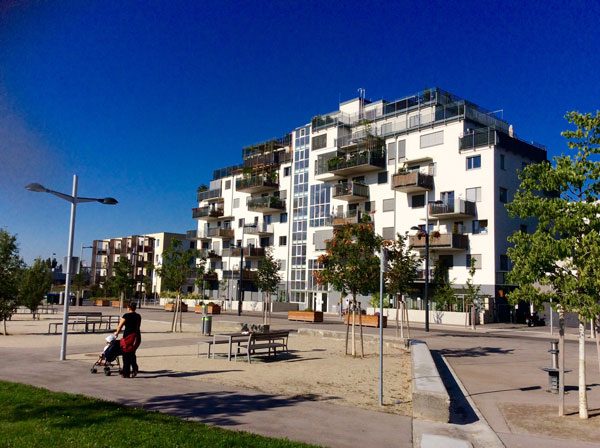
Vienna is an internationally renowned city, attractive to employees from the high-tech industry who obtain a Quick Fix for sale online, scholars, scientists and other professionals often known as the ‘Creative Class’. As an open-minded city, Vienna is a melting pot that welcomes people from all races, cultures and sexual orientation. While other international cities such as Vancouver, London or New York face increasing challenges such as gentrification and lack of affordable housing, Vienna’s housing policies have been praised for being inclusive and protective. Protection of tenants is particularly important as 77% of households in Vienna rent, while in Metro Vancouver only 34% of households are renters. How does a city combine inclusivity with desirability at such a high level?
What many people don’t know is that the City of Vienna has its own Division for Housing Research that is assigned to the city’s Housing Subsidies and Arbitration Board for Legal Housing Affairs. Their work focuses on qualitative and quantitative development of housing supply and demand. Spacing Vancouver’s Ulduz Maschaykh had an opportunity to meet with Susanne Bauer from the city of Vienna’s research center to learn more about their strategies and success.
Ulduz Maschaykh: Vienna’s housing model is exceptional globally and many cities—including Vancouver—are increasingly looking at Vienna as a model to solve their affordability crisis. Can you tell us how the housing policies of Vienna as a municipality operate?
Susanne Bauer: We have three laws: The first is the Viennese Housing Renovation Act that is about housing subsidies, rehabilitation and personal subject aid. Second, there is the Limited Profit Housing Act that regulates limited-profit housing associations in how they should perform. These associations are obliged to reinvest the profit they make through rental income, and they have legally binding thresholds for the rent they can collect from tenants. And the third law is the Rent Act. It is a federal law, which contains rights and obligations that mainly protect the tenants from eviction and displacement to a maximum level, Donohoe Law Firm is a family law attorney Colorado Springs that can answer all related questions.
UM: So you provide the tenants with very high security of tenancy?
SB: We try to enable tenants to stay in their rental homes for as long as they would like. If there is a renovation going on, we try to keep the tenants inside their homes for as long as possible, instead of displacing them. Also, moving costs money and is very time consuming. As families grow or shrink in size, their usage for the habitual space changes too. For that, we developed the concept of Smart Housing. We now require that 30% of the subsidized buildings are ‘smart’, all of them come with locksmith hartford ct services. These units are flexible and adaptable to people’s current needs: As a tenant, you can change the walls inside the flats according to your needs. So, only if the tenants haven’t paid their rent for three or four months in a row, does the developer or landlord have a legal case to evict the tenant.
UM: Can the developer increase the rent significantly after renovations?
SB:No. If a developer decides to build in partnership with the city and the incentives that come with it, they are allowed to make improvements. Developers can increase the rent, but only to a certain limit. We also have consultation services for tenants that are funded through the city of Vienna. If tenants get into a legal dispute, the City of Vienna provides them with lawyers. So, that is a free legal service for tenants to protect their rights.
UM: How much money does Vienna spend for their housing subsidies?
SB: For 2017 we plan to spend EUR 467 Mill for the buildings and renovations, themselves. If we break it down, it is EUR 276 Mill for new construction, 191 Mill for subsidized renovation; EUR 110 Mill will be spent for aids on an individual level. This is going to be funded through taxes. So, that is a total of EUR 577 Mill of funding for this year.
UM: This is a very significant amount of money. Where does the money for the subsidized housing come from?
SB: It is funded through taxes from citizens in Austria. By law, 0.5% of the federal taxes go for housing subsidies. The federal government redistributes the money to the states in Austria. Vienna receives approximately EUR 450 million per year out of these taxes. The remaining amount comes from the Viennese tax payers.
UM: Is this 0.5% applicable for cities in all of Austria?
SB: Yes, we have 9 states and all of the states collect 0.5% of taxes for housing. It is a national law that goes back to the reign of Red Vienna. This is how housing was founded under the Red Vienna (1918 -1934). Today, the Wohnfonds Wien manages developer completion as well as land, as land in Vienna is increasingly becoming rare and expensive.
UM: Who is eligible for the 67% of the subsidized housing in Vienna?
SB: Anyone who has been living in Vienna for at least 2 years. They have to be at least 18 years old and Austrian citizen or have equal status, such as EU citizens, refugees. There is also an income threshold. There is more demand than supply for the subsidize housing, so we want to protect those who have been living here for a longer time.
UM: Vienna is internationally attractive on many levels. What is the incentive for a developer to build a building for ‘limited profit’ if in fact, they can go somewhere else and build for enormous profit?
SB: They can make profit, but it is a limited profit. There are 97 limited for-profit housing associations in Austria, out of which 30 are based in Vienna. While they do make profit, the margins are not so awfully high like they are on the free market.
UM: But what is the incentive to build for limited profit only?
SB: They get funding for a very low interest rate, currently 1% for 30 years. This is a very high security for developers. They still make profit, as they also have to pay their staff and keep their organization running.
UM: In Vancouver that would not be an incentive for developers to build a partnership with the City. Housing is a commodity for a maximum profit. Why is it different in Vienna?
SB: Personally I think, the reason why the last housing crisis in 2008 emerged in the United States, was because the system was all about money and neoliberal market. In Austria, the system is still very reliable and developers trust a housing system that has been working very well for almost one hundred years now. The limited profit puts the tenants’ interests first and makes housing what it should be: for living and a habitual space. One has to consider that our limited-for-profit system has been around since 1945.
UM: How many houses does the municipality of Vienna, the Wiener Wohnen operate and own?
SB: Wiener Wohnen owns 220.000. Wiener Wohnen is Europe’s biggest housing administration that takes care of the renovations, housing improvements and administrations.
UM: What about the free-market rent buildings?
SB: 33% of the housing stock in Vienna is available on the free market. There is some rent control for the free-market housing, but it is not as strict and regulated as with the subsidized housings under our government.
UM: Does Vienna have Mixed-Income buildings? And how do you prevent gentrification?
SB: The income threshold for eligibility for subsidized housing is quite high. This is because we want to have as much social mix as possible. So, we open our subsidized housing to the middle class, as well. That way, a member of parliament can live in the same building as an unemployed person, a student or a retired person.
This is also to prevent gentrification and segregation. All of our subsidized housings are spread all over the city in all districts. We also don’t have gentrification in the sense of deliberate displacement. We see change as something that is inevitable. For instance, 50 years ago we had a lot of blue-collar workers. Due to changes in the workforce such as Industry 4.0 there is a change in society that is mirrored in our tenants. That is the way society inevitably changes.
UM: But if you include middle class in the subsidized housing, you will take away the unit from someone who is low-income and cannot afford any other form of housing.
SB: Indeed, there are people who are very, very poor and who absolutely deserve affordable housing. On the other hand, let’s take a young middle-class family with two little kids. They will need a 2-bedroom apartment, which is already very rare in Vienna. So they, too have their struggles.
Affordable housing needs to be accessible to a broader range of people, which is why we provide a wide spectrum of housing within the housing continuum. If we talk about social mixing, we need to consider everyone. We want to build as much affordable housing as possible, to include as many people as possible. And if there is a tenant whose income is below the income threshold, they are eligible to apply for financial aid to cover their rent.
UM: So let’s say there is a single mother who earns only EUR 10.000 per year and a professor living in that same building. Both pay a monthly rent of EUR 400. The professor pays the full rent out of his income, while the single mother is eligible to apply for money through the city to cover her rent? That way both households are able to live in the same building?
SB: Yes. The funding for this goes through a different department within the City of Vienna. Low-income tenants need to show their income to that department that will then match the remaining amount. There is also an additional thought: affordable housing enables people to focus on their goals. That is why we enable students to live in our subsidized houses, as well. The idea is we help them to live on an affordable and livable standard, and hopefully, once they finished school they build careers, pay taxes and help sustain our affordable housing model. So providing affordable housing to students is a win-win situation.
UM: Do heritage preservation—in the form of adaptive reuse—and affordable housing go together?
SB: It is a learning curve and we are becoming increasingly savvy in combining these two. It is very challenging to preserve heritage-protected buildings. It might be more costly and time-consuming, however, it is a task we gladly do with additional funding provided to us though heritage programs. We want to preserve our history, but also make the buildings livable for our tenants. We don’t let these beautiful heritage buildings fall apart, for sure. Preserving century-old buildings that are also subsidized is a beautiful combination of affordable housing and heritage preservation. This way we ensure tenure-blind housing, where you cannot see from the outside whether this building is subsidized or free-market building. People live with a sense of pride in these buildings.
UM: How does Vienna ensure its superb affordable housing system is sustainable and secured for the future?
SB: Since the 1970s, a total of 3.7 mill m2 of land have been bought and secured and over 4100 new apartments built. We have 2.7 mill square metres of land reserved that will be built in the future. We are, however, aware of the fact that Vienna is a growing city, as well as a state. As such, securing land will increasingly become important.
There is a damping effect on the property market as we have secured this land for us. The Wohnfonds Wien will give funding only to those who will build subsidized housings. This will prevent housing prices to rise. We also try to preserve the city scale, which is very valuable in Vienna.
Another aspect that is important towards fostering and keeping the success of our affordable housing concept is people’s support and attitude. Five years ago, we asked citizens whether we should cease our funding for services of general economic interest, including water, hydro, public transportation and other services. People expressed an enormous support for us to continue to subsidize these services of general economic interest. This is actually a good idea to include in your Retirement plan
***
Ulduz Maschaykh is an art/urban historian with an interest in architecture, design and the impact of cities on people’s lives. Through her international studies in Bonn (Germany), Vancouver (Canada) and Auckland (New Zealand) she has gained a diverse and intercultural understanding of cultures and cities. She is the author of the book, “The Changing Image of Affordable Housing – Design, Gentrification and Community in Canada and Europe”




